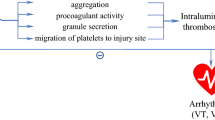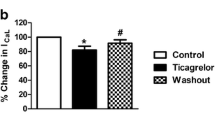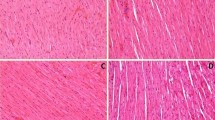Abstract
Antiplatelet agents, sarpogrelate (SAR), a 5-hydroxy tryptamine 2A receptor antagonist and cilostazol (CIL), a phosphodiesterase-III inhibitor, were observed to be beneficial in attenuating cardiac remodeling and improving cardiac function in congestive heart failure due to myocardial infarction in rats; however, CIL increased ventricular tachycardia and mortality. In order to study the effects of these antiplatelet agents on arrhythmias, Sprague–Dawley rats were pretreated with either SAR or CIL (5 mg/kg/day) for 2 weeks and were then either injected cumulative doses of epinephrine (Epi) or subjected to coronary occlusion. Saline-treated animals served as controls. Electrocardiographic analysis revealed that SAR pretreatment decreased the incidence and severity of ventricular arrhythmias (time of onset of arrhythmias as well as the occurrence of premature ventricular contractions, salvos, tachycardia, and fibrillations), whereas CIL treatment augmented the incidence of cardiac arrhythmias due to both Epi and coronary occlusion. None of the drugs affected the corrected QT interval significantly. Furthermore, the levels of cyclic adenosine monophosphate (cAMP) in left ventricle were markedly higher in CIL-pretreated rats when compared to SAR-pretreated or control rats. It is suggested that an excessive level of cAMP may contribute to increase incidence of ventricular arrhythmias and mortality in animals pretreated with CIL, unlike the SAR-pretreated rats.



Similar content being viewed by others
References
Sorkin, E. M., & Markham, A. (1999). Cilostazol. Drugs and Aging, 14, 63–71. doi:10.2165/00002512-199914010-00005.
Igarashi, M., Okuda, T., Oh-i, T., & Koga, M. (2000). Changes in plasma serotonin concentration and acceleration plethysmograms in patients with Raynaud’s phenomenon after long-term treatment with a 5-HT2 receptor antagonist. Journal of Dermatology, 27, 643–650.
Tsuchikane, E., Fukuhara, A., Kobayashi, T., Kirino, M., Yamasaki, K., Kobayashi, T., et al. (1999). Impact of cilostazol on restenosis after percutaneous coronary balloon angioplasty. Circulation, 100, 21–26.
Fujita, M., Mizuno, K., Ho, M., Tsukahara, R., Miyamoto, A., Miki, O., et al. (2003). Sarpogrelate treatment reduces restenosis after coronary stenting. American Heart Journal, 145, E16. doi:10.1067/mhj.2003.176.
Sharma, S. K., Del Rizzo, D. F., Zahradka, P., Bhangu, S. K., Werner, J. P., Kumamoto, H., et al. (2007). Sarpogrelate inhibits serotonin-induced proliferation of porcine coronary artery smooth muscle cells: Implications for long-term graft potency. Annals of Thoracic Surgery, 7, 1856–1865.
Saini, H. K., Takeda, N., Goyal, R. K., Kumamoto, H., Arneja, A. S., & Dhalla, N. S. (2004). Therapeutic potentials of sarpogrelate in cardiovascular disease. Cardiovascular Drug Reviews, 22, 27–54.
Nagatomo, T., Rashid, M., Abul Muntasir, H., & Komiyama, T. (2004). Functions of 5-HT2A receptor and its antagonists in the cardiovascular system. Pharmacology and Therapeutics, 104, 59–81. doi:10.1016/j.pharmthera.2004.08.005.
Saini, H. K., Sharma, S. K., Zahradka, P., Kumamoto, H., Takeda, N., & Dhalla, N. S. (2003). Alteration of serotin-induced increase in intracellular calcium in rat aortic smooth muscle cells by sarpogrelate. Canadian Journal of Physiology and Pharmacology, 81, 1056–1063. doi:10.1139/y03-108.
Fan, G., Jiang, Y. P., Lu, Z., Martin, D. W., Kelly, D. J., Zuckerman, J. M., et al. (2005). A transgenic mouse model of heart failure using inducible Galpha q. Journal of Biological Chemistry, 280, 40337–40346. doi:10.1074/jbc.M506810200.
Grover, G. J., Sargent, C. A., Dzwonczyk, S., Normandin, D. E., & Antonaccio, M. J. (1993). Protective effect of serotonin (5-HT2) receptor antagonists in ischemic rat hearts. Journal of Cardiovascular Pharmacology, 22, 664–672. doi:10.1097/00005344-199310000-00022.
Du, X. J., Anderson, K. E., Jacobsen, A., Woodcock, E. A., & Dart, A. M. (1995). Suppression of ventricular arrhythmias during ischemia-reperfusion by agents inhibiting Ins(1, 4, 5)P3 release. Circulation, 91, 2712–2716.
Shimizu, Y., Minatoguchi, S., Hashimoto, K., Uno, Y., Arai, M., Wang, N., et al. (2002). The role of serotonin in ischemic cellular damage and the infarct size-reducing effect of sarpogrelate, a 5-hydroxytryptamine-2 receptor blocker, in rabbit hearts. Journal of the American College of Cardiology, 40, 1347–1355. doi:10.1016/S0735-1097(02)02158-7.
Zehender, M., Meinertz, T., Hohnloser, S., Geibel, A., Hartung, J., Seiler, K. U., et al. (1989). Incidence and clinical relevance of QT prolongation caused by the new selective serotonin antagonist ketanserin. Multicenter Ketanserin Research Group. The American Journal of Cardiology, 63, 826–832. doi:10.1016/0002-9149(89)90051-9.
Temsah, R. M., Kumamoto, H., Takeda, N., & Dhalla, N. S. (2001). Sarpogrelate diminishes changes in energy stores and ultrastructure of the ischemic-reperfused rat heart. Canadian Journal of Physiology and Pharmacology, 79, 761–767. doi:10.1139/cjpp-79-9-761.
Brasil, D., Temsah, R. M., Kumar, K., Kumamoto, H., Takeda, N., & Dhalla, N. S. (2002). Blockade of 5-HT(2A) receptors by sarpogrelate protects the heart against myocardial infarction in rats. Journal of Cardiovascular Pharmacology and Therapeutics, 7, 53–59. doi:10.1177/107424840200700i108.
Packer, M., Carver, J. R., Rodeheffer, R. J., Ivanhoe, R. J., DiBianco, R., Zeldis, S. M., et al. (1991). Effect of oral milrinone on mortality in severe chronic heart failure. The PROMISE Study Research Group. New England Journal of Medicine, 325, 1468–1475.
Cohn, J. N., Goldstein, S. O., Greenberg, B. H., Lorell, B. H., Bourge, R. C., Jaski, B. E., et al. (1998). A dose-dependent increase in mortality with vesnarinone among patients with severe heart failure. Vesnarinone Trial Investigators. New England Journal of Medicine, 339, 1810–1816.
Trolese-Mongheal, Y., Barthelemy, J., Paire, M., & Duchene-Marullaz, P. (1992). Arrhythmogenic potencies of amrinone and milrinone in unanesthetized dogs with myocardial infarct. General Pharmacology, 23, 95–104. doi:10.1016/0306-3623(92)90054-N.
Wang, S., Cone, J., Fong, M., Yoshitake, M., Kambayashi, Ji., & Liu, Y. (2001). Interplay between inhibition of adenosine uptake and phosphodiesterase type 3 on cardiac function by cilostazol, an agent to treat intermittent claudication. Journal of Cardiovascular Pharmacology, 38, 775–783. doi:10.1097/00005344-200111000-00014.
Gamssari, F., Mahmood, H., Ho, J. S., Villareal, R. P., Liu, B., Rasekh, A., et al. (2002). Rapid ventricular tachycardias associated with cilostazol use. Texas Heart Institute Journal, 29, 140–142.
Sanganalmath, S. K., Babick, A. P., Barta, J., Kumamoto, H., Takeda, N., & Dhalla, N. S. (2007). Antiplatelet therapy attenuates subcellular remodeling in congestive heart failure. Journal of Cellular and Molecular Medicine. doi:10.1111/j.1582-4934.2007.00197.
Sanganalmath, S. K., Barta, J., Kumamoto, H., Takeda, N., & Dhalla, N. S. (2008). Antiplatelet therapy mitigates cardiac remodeling and dysfunction in congestive heart failure due to myocardial infarction. Canadian Journal of Physiology and Pharmacology, 86, 180–189. doi:10.1139/Y08-005.
Podzuweit, T. (1980). Catecholamine-cyclic AMP Ca2+-induced ventricular tachycardia in the intact pig heart. Basic Research in Cardiology, 75, 772–779. doi:10.1007/BF01910455.
Podzuweit, T., Els, D. J., & McCarthy, J. (1981). Cyclic AMP mediated arrhythmias induced in the ischemic pig heart. Basic Research in Cardiology, 78, 443–448. doi:10.1007/BF01908339.
Kirshenbaum, L. A., Gupta, M., Thomas, T. P., & Singal, P. K. (1990). Antioxidant protection against adrenaline-induced arrhythmias in rats with chronic heart hypertrophy. Canadian Journal of Cardiology, 6, 71–74.
Dixon, I. M., Lee, S. L., & Dhalla, N. S. (1990). Nitrendipine binding in congestive heart failure due to myocardial infarction. Circulation Research, 66, 782–788.
Walker, M. J., Curtis, M. J., Hearse, D. J., Campbell, R. W., Janse, M. J., Yellon, D. M., et al. (1998). The Lambeth conventions: Guidelines for the study of arrhythmias in ischaemia infarction, and reperfusion. Cardiovascular Research, 22, 447–455. doi:10.1093/cvr/22.7.447.
Damiano, B. P., & Rosen, M. R. (1984). Effects of pacing on triggered activity induced by early afterdepolarizations. Circulation, 69, 1013–1025.
Wellens, H. J., Brugada, P., & Farre, J. (1984). Ventricular arrhythmias: Mechanisms and actions of antiarrhythmic drugs. American Heart Journal, 107, 1053–1057. doi:10.1016/0002-8703(84)90174-1.
Singh, B. N., & Wadhani, N. (2004). Antiarrhythmic and proarrhythmic properties of QT-prolonging antianginal drugs. Journal of Cardiovascular Pharmacology and Therapeutics, 9, S85–S97. doi:10.1177/107424840400900107.
Goldstein, R. A., Geraci, S. A., Gray, E. L., Rinkenberger, R. L., Dougherty, A. H., & Naccarelli, G. V. (1986). Electrophysiologic effects of milrinone in patients with congestive heart failure. American Journal of Cardiology, 57, 624–628. doi:10.1016/0002-9149(86)90847-7.
Lynch, J. J., Jr., Uprichard, A. C., Frye, J. W., Driscoll, E. M., Kitzen, J. M., & Lucchesi, B. R. (1989). Effects of the positive inotropic agents milrinone and pimobendan on the development of lethal ischemic arrhythmias in conscious dogs with recent myocardial infarction. Journal of Cardiovascular Pharmacology, 14, 585–597. doi:10.1097/00005344-198910000-00010.
Piwonka, R. W., Healey, J. F., Canniff, P. C., & Farah, A. E. (1983). Electrophysiological actions of amrinone in dogs with cardiac lesions. Journal of Cardiovascular Pharmacology, 5, 1052–1057. doi:10.1097/00005344-198311000-00021.
Kaumann, A. J., Sanders, L., Brown, A. M., Murray, K. J., & Brown, M. J. (1990). A 5-hydroxytryptamine receptor in human right atrium. British Journal of Pharmacology, 100, 879–885.
Brasil, D. P., Wang, X., Kumar, K., & Dhalla, N. S. (2000). Increased 5-HT, angiotensin II and endothelin 1-induced [Ca2+]i responses in aortic smooth muscle cells due to volume overload: Efficacy of the specific 5-HT2A receptor antagonist sarpogrelate. Latin American Archives of Cardiovascular Science, 1, 54–65.
Lukas, A., & Ferrier, G. R. (1988). Electrophysiological effects of amrinone and milrinone in an isolated canine cardiac tissue model of ischemia and reperfusion. Journal of Pharmacology and Experimental Therapeutics, 244, 348–354.
Packer, M., Medina, N., & Yushak, M. (1984). Failure of low doses of amrinone to produce sustained hemodynamic improvement in patients with severe chronic congestive heart failure. American Journal of Cardiology, 54, 1025–1029. doi:10.1016/S0002-9149(84)80138-1.
Pflugfelder, P. W., O’Neill, B. J., Ogilvie, R. I., Beanlands, D. S., Tanser, P. H., Tihal, H., et al. (1991). A Canadian multicentre study of a 48 h infusion of milrinone in patients with severe heart failure. Canadian Journal of Cardiology, 7, 5–10.
Cheng, J. W. (1999). Cilostazol. Heart Disease, 1, 182–186.
Schror, K. (2002). The pharmacology of cilostazol. Diabetes, Obesity and Metabolism, 4, S14–S19. doi:10.1046/j.1463-1326.2002.0040s2s14.x.
Shakur, Y., Fong, M., Hensley, J., Cone, J., Movsesian, M. A., Kambayashi, J., et al. (2002). Comparison of the effects of cilostazol and milrinone on cAMP-PDE activity, intracellular cAMP and calcium in the heart. Cardiovascular Drugs and Therapy, 16, 417–427. doi:10.1023/A:1022186402442.
Van de Water, A., Xhonneux, R., Reneman, R. S., & Janssen, P. A. (1992). Cardiac and hemodynamic effects of intravenous R80122, a new phosphodiesterase III inhibitor, in a canine model of myocardial ischemia and heart failure. Journal of Cardiovascular Pharmacology, 20, 18–24. doi:10.1097/00005344-199207000-00004.
Matsui, K., Kiyosue, T., Wang, J. C., Dohi, K., & Arita, M. (1999). Effects of pimobendan on the L-type Ca2+ current and developed tension in guinea-pig ventricular myocytes and papillary muscle: comparison with IBMX, milrinone, and cilostazol. Cardiovascular Drugs and Therapy, 13, 105–113. doi:10.1023/A:1007779908346.
Acknowledgments
The work reported in this study was supported by a grant from the Canadian Institutes for Health Research (CIHR). J.B. was supported by the TACTICS program in association with CIHR and the Heart and Stroke Foundation of Canada. SAR was kindly supplied by Mitsubishi Pharma Corporation, Osaka, Japan, whereas CIL was obtained from Otusuka America Pharmaceutical Inc., Rockville, MD, USA.
Author information
Authors and Affiliations
Corresponding author
Rights and permissions
About this article
Cite this article
Barta, J., Sanganalmath, S.K., Kumamoto, H. et al. Antiplatelet Agents Sarpogrelate and Cilostazol Affect Experimentally-induced Ventricular Arrhythmias and Mortality. Cardiovasc Toxicol 8, 127–135 (2008). https://doi.org/10.1007/s12012-008-9019-x
Received:
Accepted:
Published:
Issue Date:
DOI: https://doi.org/10.1007/s12012-008-9019-x




